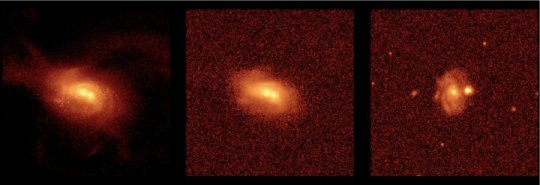[ad_1]
Galaxy mergers — in which two galaxies join together over billions of years in sometimes-dramatic bursts of light — aren’t always easy for astronomers to spot. Now, scientists from the University of Colorado Boulder have developed a new technique for finding these cosmic couplings in surveys of the night sky.
In new research, a team led by Rebecca Nevin designed a computer program that scans through surveys of galaxies to look for a wide range of signs that a merger might be happening. That includes the shape of the resulting galaxies and how the stars inside are moving.
That’s important, Nevin said, because such mergers may be an important step in the building of huge, spiral galaxies like the Milky Way and in kicking off the formation of new stars.
She will present her group’s findings Jan. 8 at a press briefing at the 233rd Meeting of the American Astronomical Society in Seattle.
“The goal is to build a bigger sample of merging galaxies than ever before,” said Nevin, a graduate student in the Department of Astrophysical and Planetary Science (APS).
Nevin’s work builds on observations from the Sloan Digital Sky Survey (SDSS), a long-running census of the night sky undertaken by a research partnership that includes CU Boulder. Scientists on that survey have snapped about 500 million images of space since 1998, many of them showing galaxies far away from Earth.
But to date, no one technique has been able to look through such surveys and find all types of galaxy mergers at all stages in their development, Nevin said.
“People have been looking at pictures of galaxies and saying, ‘that’s a merger” or ‘that’s not a merger,'” she said. “But people are also really bad at doing that, and they miss a lot of galaxies.”
To locate those missing mergers, Nevin and her colleagues designed a series of simulations that seek to capture a wide range of different ways that two galaxies might bump into each other.
“These simulated galaxy mergers allow us to follow billions of years of evolution directly, whereas observations of real galaxies are limited to single moments in time,” said Laura Blecha, an assistant professor at the University of Florida who led the simulation work.
The researchers used those simulations to train a computer program to recognize the telltale fingerprints of these unions. The team, which included Julia Comerford of CU Boulder and Jenny Greene of Princeton University, then employed the same program to scan real-life images of galaxies collected by the SDSS.
And it worked: depending on the types of galaxies involved the team’s technique could correctly identify fusing galaxies 80 percent of the time or more. Nevin and her colleagues will publish their findings shortly in The Astrophysical Journal.
The group didn’t stop there. She and her colleagues are also working to incorporate measurements of the way that stars in a galaxy move, or their “kinematics,” into the hide-and-seek tool.
“This is a novel approach because it’s bringing imaging techniques and the kinematics together,” Nevin said.
Story Source:
Materials provided by University of Colorado at Boulder. Note: Content may be edited for style and length.
[ad_2]















